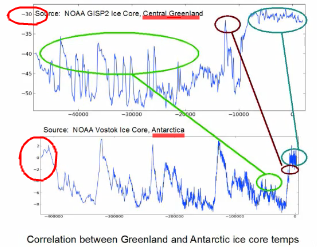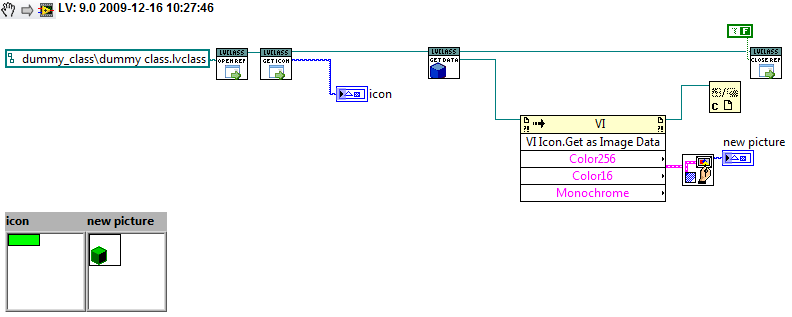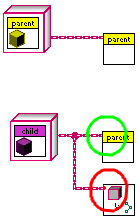-
Posts
1,213 -
Joined
-
Last visited
-
Days Won
49
Content Type
Profiles
Forums
Downloads
Gallery
Everything posted by Francois Normandin
-
True, it's happened in the earth's past. The big difference between the carbonaceous era and now is that we've stripped the forests around the world and wood growth doesn't compensate for our increased "exhalations". As a matter of fact, CO2 is a greenhouse gas. One of many. That you don't believe its increase to be a problem is something, but it definitely is a greenhouse gas. What do you think is the major difference between Mars, Venus and Earth? In the past (way past, before those ice cores measurements), each of these three planets could have evolved to be hospitable to life. It happens that, to the best of current knowledge in the planetary science community, Mars' surface being colder than its sister planets, it trapped larger quantities of CO2 in its rocks in a process analog to your laboratory cryogenic vacuum pumps. The CO2 atmosphere thinned out (6 mbar pressure as of today) and there was very little greenhouse effect that could compensate its greater distance to the sun. Venus was exactly the opposite, as it didn't trap the CO2, it amplified to produce a thick atmosphere with, nowadays, a very complex atmospheric structure involving acid rain, nitrous oxides and dense clouds, most of which contribute highly to the greenhouse effect. Of course, no point in stating the obvious for Earth... So a higher CO2 content could be balanced by an increase in vegetation? Sure. Provided we let the vegetation grow. Provided also that those trees we cut are not replaced with millions of cows that exhale CO2 and produce methane in large quantities. Methane, by the way, is the third predominant greenhouse gas... but being equivalent to 21 times the greenhouse effect of CO2 by weight, we would indeed be wise to let more forests untouched. Methane is also very much present is permafrost, which is at risk of not staying permanent if we let the temperature rise too much. Would it be balanced by an increase in vegetation cover? Again, maybe... provided we don't cut the trees... Oh yeah, I said that already. Chicken and the egg: whichever came first. Is CO2 a pollutant. Yes and no. It's referred to as a "fund pollutant" when it's produced in greater quantity than the absorptive capacity of the environment. This means that it might not be a pollutant yet, depending on where you stand on this issue... I believe it is, but that's just me. I watched it and felt something was odd but couldn't put my finger on it. There is indeed a source with the graphs... And then it occured to me... The temperature scales depicted are wrong. Antarctica's average temperatures are never around the freezing point. I guess they're simply mixed up. I'm not saying this is a scam or anything... but it does illustrate that you can't always believe the data you're presented at face value. This is true when you watch Al Gore's documentary... but it's even truer when you watch a video on Youtube. Cross-referencing with real scientific data and making sure we cite other people which are not related to us that have done similar work (and building on them or refuting them) is the true way to scientific inquiry. I don't know why you accuse people on LAVA of being such illiterate people. If you want to tease us, please use some emoticons... Otherwise we might think you're being serious! I've found that people hanging here, and it's been said many times by others, are quite knowledgeable in many fields of interest. The first trait of collective intelligence I value when people communicate, is their ability to express themselves with the right words (sycophant, calumniable, etc.) , without making too many grammatical or orthographic mistakes. The large majority or English-speaking people here can write a concise text without notable errors, as well as many foreigners... This is truly an amazing bunch we have here.
-

The question about password of block diagram
Francois Normandin replied to FengDe's topic in LabVIEW General
You have to know that even with a weak password, there's still at least a 100ms lag between each successive password trials... so you might want to follow on Ben's advice and start over. -
And there's no signature on this article... and no references about where those graphs came from.
-
Is there such a thing as a geek "coming-out"? I've read 100+ Star Trek novels, not all shown here. And got 38% (Major Geek) in the geek test. So I think I qualify... My girlfriend calls me "My favorite geek", and I would probably find it offensive if she called me "My favorite Nerd"... So I'd have to go with Daklu's definition. There might be something lost in translation...
-
Hi Durnek, I'm the author of this package. Thanks for your comments. LabVIEW controls support transparency, but you have to make sure your source image is 32-bit PNG (24 bit RGB image + alpha channel). You can do what you want by hand, which is simplest if you have a small set of controls. First, find a drawing software that supports transparency and can output a png. Some people use PowerPoint, GIMP, PAINT.NET, etc. You can search the LAVA forums for some discussion about this. Second, use the control editor (customize button) in edit mode. Drag your image on the front panel of your Customization screen. If you see the white background, then you had a problem saving your PNG correctly with alpha channel. If you see it correctly, then all you need is copy - paste on the control using the right click on the image you wish. That's the easy way to get a transparent control. Check out this nice video by Michael Aivaliotis for a more in-depth comprehension. And here's an example of what you can do with this. If you're more advanturous, there was a discussion lately on programmatically creating controls. I've done it and will release my work soon (I'm polishing the edges...) but you can have a look at Vugie's BitMan in the code repository for manipulating bitmaps (with transparency). Also, read thisdiscussion for more info.
-
I know I'm late in this topic, but there's a utility in the CR that you can use to ease your pain: LVClass API.
-
Hi Ton, yeah, don't tell me... that was a mistake. I'll be doing an update soon with the stuff Vugie and Rolf have dug out for the programmatic creation of controls. Those won't be typedef'ed and all icons/text will have been programmatically located, so there won't be any mismatch of a pixel or two here and there as can happen when you do it manually. I actually have real nice series of buttons ready... but they take a few MBs per series and I'm thinking of a way to have it created on the fly like, I don't know, CCT or perhaps a RCF plugins? I'll spend a few nights on that and hopefully I get something useful by Xmas to show off. Anyway, here's a teaser... teasing82.vi Français... François. What's the difference? We're all alike, right?
- 54 replies
-
- alignement
- dialog
-
(and 3 more)
Tagged with:
-

Programmatically changing image within control
Francois Normandin replied to vugie's topic in VI Scripting
Hello Bjarne, indeed, you can find those in LV8.x folders. If they exist in LV2009. I haven't found them (or they changed name). -

labview Xnode _Adapt Terminal Output
Francois Normandin replied to psdv's topic in Code In-Development
A few comments, unrelated to the Xnode itself: 1- cross-post: where do you want comments on your code? We should probably stick to one thread to gather all comments at the same place. 2- I didn't find the readme file in the zip. 3- And it's password-protected...which indicates you have copyrighted content that you want to protect. It's probably in the readme file, but a license detail would help (how can we use it? At which conditions?) -
Hi Paul, I really like your combativity in those lounge subjects... but I can't resist to bite too because I sit on the other side. In Quebec (Canada again), the government introduced a universal childcare system where parents can, for a meager 7$ a day, leave their children in the good care of professionals while they go to work. This measure has grown in popularity so much that A- we need to create hundreds of new childcare centers every year (6 millions population); B- the average price in the private system is 40$ a day; C- after a stagnation of the percentage of women joining the workforce, their number has started to increase again, thus increasing overall productivity and D- there's a baby boom (finally) that's gonna be needed to take care of the babyboomers that will all take their pension soon and will very likely get massively sick in about 20 years. There are also some side effects that are difficult to pinpoint exactly because the causes are multiple, but one can't help to notice that child molestation has dropped steadily since the implantation of those childcare centers.
-
Paul, I think it's a big leap to think that because a few scientists have deleted data (if these affirmations have not been taken out of context), that all the climate scientists are covering the truth. You find a rotten apple, you expose it and take it out of the basket. You certainly don't throw the whole basket away. Agreed, you can get funded for saying global warming exists. But I'm sure you can get grants for saying the opposite too... if not from government, then from other organizations. It's not all about money. As a guy that works in a research lab, I can tell you that bad ideas (even when funded) have a tendency to die quite fast. The fact that some ideas continue to be funded after so many years means there's credit to them. Scientists are very territorial... that means that the competition (i.e. the other group in that other institute across the ocean...) must have damn good arguments to prevent me from bearing down on them, because after all, I want to be the top guy... since I want the same grant money as the ones they're applying for, I'd better be! And believe me, peer reviewed grants are very competitive. If you come with false pretense or crazy ideas that just don't fit the facts, then you won't get it. (That's another way to look at Darwinism). Yes there are probably more chances to get a grant if you try to find a way to explain climate change than if you try to find a proof it doesn't exist. But scientists are more clever than that. If you don't believe in global warming and still want some grants, apply for a grant to gather some data to explain global warming... and if you were right all along, the data will contradict global warming and you can show the world that you've got some data to corroborate your saying.
-

Programmatically changing image within control
Francois Normandin replied to vugie's topic in VI Scripting
With proper acknowledgement, it's gonna be a pleasure... thanks again. -

Programmatically changing image within control
Francois Normandin replied to vugie's topic in VI Scripting
When I feel better, I'll try it. I got swine flu apparently. -

Open Office Toolkit
Francois Normandin replied to Francois Normandin's topic in Database and File IO
I should really have read your post earlier, Ton. At least, I get to use your CCT 2.0. Great work. BTW, the link to the "thank you" page needs to be refreshed (LAVA 1.0). If you can fix it, I'd pay my regards. -

Open Office Toolkit
Francois Normandin replied to Francois Normandin's topic in Database and File IO
On your advice, I checked the hierarchy of vi.lib/Utility/NiReport.llb and I will create two child classes "ooWriter" & "ooCalc" that will inherit from NI_report.lvclass. It should then be only a matter of adding these two choices to the selector enum of "New Report.vi" and voilà. I think that's the spirit behind OOP, isn't it? -

Coercion dot on LabVIEW Object
Francois Normandin replied to Francois Normandin's topic in Object-Oriented Programming
I'll be damned. If you can find that document, I'll be sure to read it. I remember seing something about that a while back but can't find it either. I'll start by browsing AQ's posts... Thanks Jon, -

Programmatically changing image within control
Francois Normandin replied to vugie's topic in VI Scripting
You know you're gonna make tons of happy people. I'll be able to automate the UI Tools button creation. -

Open Office Toolkit
Francois Normandin replied to Francois Normandin's topic in Database and File IO
I don't know why, but I missed your answers guys! I guess I should "track" my topics. Thanks for the feedback. I indeed thought I could mirror the NI Report Generation VIs for the Basic Reports palette. The rest of the code would be hidden inside those to control individually cells, paragraphs and graphics. That's the approach I'll take for the first version. Building on that can be transparent for the end-user of the library. Still, I found some bumps in the current implementation of the AODL 1.3 library. Its behavior is not polished to the point where it's as easy as OfficeReport. I'll try to document that a little. -
I feel naughty every time I see a coercion dot on my block diagrams and try to get rid of them as often as possible. But there's one case for which I don't understand why there's a coercion dot in the first place: wiring an object to its ultimate ancestor, the LabVIEW object. A child wired to its parent class method will not show the dot, but wiring any object to the LV object terminal will. Would there be an instance when this is necessary to notify us we're about to use the inheritance in a potentially unintended way?
-

Oxford Word of the Year 2009
Francois Normandin replied to Francois Normandin's topic in LAVA Lounge
In that perspective, it would mean: to remove from the community*. *Friend classes appear under "Community" access scope. -
Yes, version 9.0 is LabVIEW 2009, the newest.
-
Did you know that "Unfriend" has been chosen the Word of the Year by the "New Oxford American Dictionary".
-

Here's your chance to catch my post count
Francois Normandin replied to crelf's topic in LAVA Lounge
Congratulations Chris! -
Hi Norm, thanks for the comments. Yes, I planned to add all ;)as much as possible of the Nuvola theme icons in there, but the process is long without being able to do that programmatically. Also, I'm putting 100% of my free home time on the Open Office Report Generation (which should come in a few weeks) and then I'll go back to the UI tools copy/paste for buttons. I've already made programmatically all the buttons states in PNG using Vugie's Bitman tools. All remaining is sitting a long night and make it happen. I already received a comment that at least one of my button is misaligned (hover) so I plan to make them all from scratch calculating the exact placement of the icons. Truth be told, I hadn't thought about using something other than linear fade. I'll definitely give it a try and add this option to the UI Tools. I'll take your word on the fact that it's nicer looking... I'll put exponential as the default case and linear as option. If anybody thinks of other fading algorithms they'd like, I can integrate them as well. I'll check on ni.com's suggested features to make sure "scalable graphics" support for button edition is in there (and properly kudoed)...
- 54 replies
-
- alignement
- dialog
-
(and 3 more)
Tagged with:
-
I'm not sure those are the ones you're referring to. These are Nuvola-style. UI Tools If not, perhaps you've seen them on the NI forums?







